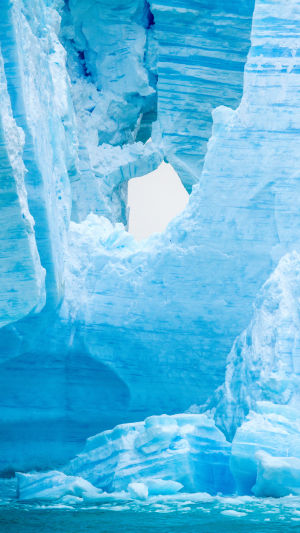Antarctica, the coldest, driest, and stormiest continent on Earth, remains one of the least explored by humans. Its vast expanse is covered with thick ice, averaging around 2 kilometers in thickness and reaching over 4 kilometers at its thickest point.
These massive ice sheets harbor approximately 70% of the world's freshwater resources. If all the ice were to melt, global sea levels would rise by approximately 60 meters.
Antarctic glaciers serve as crucial reservoirs of freshwater resources. Scientific research indicates that the water stored in the Antarctic ice sheet is sufficient to sustain the world's rivers for an extended period. These glaciers are typically classified into two categories: inland ice sheets and ice shelves.
Inland ice sheets encompass the expansive ice masses that extend beyond the coastline, covering a significant portion of Antarctica. Conversely, ice shelves are ice sheets that extend over the ocean, formed by the flow of glaciers from inland ice sheets into the sea.
Icebergs, consisting of floating freshwater ice, break off from the seaward ends of glaciers or ice shelves. These icebergs can be found in the oceans surrounding Antarctica, as well as in the Arctic Ocean and its adjacent fjords, and in lakes formed by glaciers. The Antarctic continent itself is blanketed by a massive ice body known as the "Antarctic Ice Sheet."
Antarctic glaciers are formed by the accumulation of the Antarctic ice sheet, which represents the most prominent ice body in Antarctica and the largest ice cap on the continent.
Situated in one of the coldest regions worldwide, Antarctica experiences an average temperature of -10°C and is one of the areas most severely affected by global warming.
The volume of the Antarctic ice sheet measures approximately 27 million cubic kilometers. The ice shelf is situated along the periphery of the Antarctic ice sheet, with one end connected to the mainland ice sheet while the other end floats on the sea, resulting in a relatively stable position.
However, owing to its predominantly marine location, the ice shelf experiences fluctuations with the tide.
Antarctic glaciers play a vital role within the Antarctic ecosystem, exerting considerable influence on the atmosphere, oceans, land, and climate. Particularly, glaciers have profound impacts on water and soil dynamics.
Recent years have witnessed significant changes in Antarctic glaciers as evidenced by satellite observations and ground measurements. One notable change is the accelerated rate of glacial melting.
Research suggests that certain regions of the Antarctic ice sheet are experiencing intensified melting, consequently contributing to rising sea levels.
This accelerated melting can primarily be attributed to global warming. Warmer ocean water erodes the underside of the ice shelf, causing it to thin and even collapse. Consequently, the flow of ice from the mainland into the ocean is expedited, resulting in rising sea levels.
The transformations occurring in Antarctic ice bear critical implications for global climate and ocean circulation. Firstly, the melting glaciers lead to rising sea levels, posing threats to coastal populations and ecosystems.
Secondly, the release of freshwater stored in the Antarctic ice sheet into the ocean impacts ocean salinity and density, thereby influencing the global ocean circulation system. This has a significant regulating effect on the global climate.
Moreover, the melting of Antarctic glaciers releases a substantial number of icebergs and moraine, which in turn affect marine ecosystems and biodiversity.
Addressing the preservation of Antarctic glaciers and combatting global climate change necessitates collaborative efforts from the international community. Key actions include reducing greenhouse gas emissions and increasing investments in renewable energy, while simultaneously decreasing reliance on fossil fuels.





